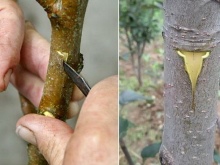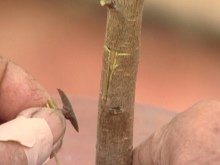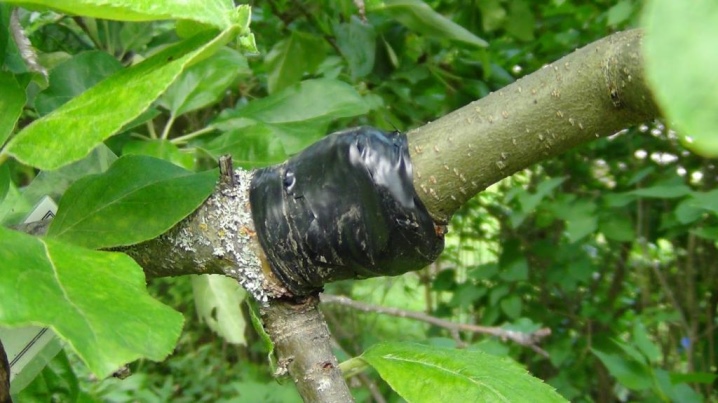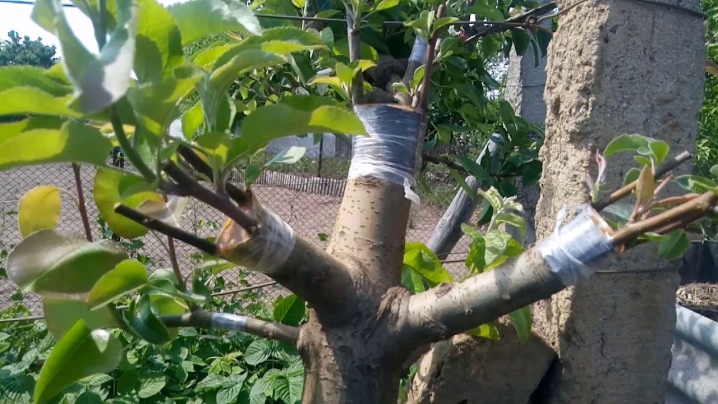Features of grafting an apple tree in summer

Many gardeners appreciate a tree such as an apple tree for its simplicity in care and the taste of the fruit. To make the fruits of the apple tree very sweet and large, gardeners graft cuttings. Such an event can be held from spring to autumn. Some amateurs do not even know that summer vaccination is the most promising. Let's consider this issue in more detail.

Advantages and disadvantages
Grafting an apple tree in the summer. There are more pluses than minuses in this matter. Consider the positives.
- You save time. After cultivating the apple tree, you will see the result in a year.
- In the summer, cuttings are very easy to prepare.... If you harvest them in the fall, then you will need to save them correctly so that they do not lose their qualities.
- Summer time contributes to the full fusion of the cutting with the base... Such fusion eliminates additional costs and special care for the grafted apple trees.
- When an apple tree is grafted in the summer, then at the site of vaccination, so-called influxes very rarely appear.
- You can make sure in the fall that the vaccine was successful.
It must be emphasized once again that planting an apple tree in the summer is correct. However, in this case, one minus must be taken into account: if the summer is dry, then there may be a risk that the stalk will not take root.

Timing
Grafting a fruit tree is a manipulation that involves transplanting a cutting onto a tree. Gardeners often use this method to improve the quality of the fruit, as well as in order to get a new variety.
Usually apple trees are grafted in summer: in July or August. First, pears are grafted, and only then apple trees. The sun is very active in summer. In addition, any tree has a root system that returns to normal by this time. It is these components that are a good incentive for the coalescence of two viable halves.
The first summer operation to graft the cutting can be done at the end of May and at the beginning of June. In this matter, you need to monitor the sap flow. Sap flow begins when the first green tip appears in the rootstock buds.
After grafting, the stalk will begin to feed on the sap of the main tree through the connective tissue, and grow quickly. And active sap flow promotes good separation of bark from wood. There is cambium under the bark. It is a building material that promotes splicing.
In the fall, the apple tree can be grafted until mid-September. The manipulation must be completed before the onset of cold weather.

Preparation
Before cutting the cutting, you need to determine the exact place on the tree where you will subsequently graft it. Remember that the vaccination site must be correctly selected and well processed.
Here's how to proceed.
Do not plant the cutting in the very center of the base or in the lower part of the crown. It is also impossible to install the stalk at the very end of mature branches. And keep in mind that if you plant a stalk at the very top of the tree, you will spend a lot of time removing subsequent shoots, and your developing shoot will not receive the necessary nutrition.
At the site of the wound that remains after pruning, pests can multiply. Therefore, ensure cleanliness during the operation. To do this, prepare an antiseptic in advance.
Choose a place for grafting that will allow the grafted cuttings to come to the fore. To do this, over time, you will need to remove old branches.
In this case, your grafted stalk will become a favorite and give hope for a good harvest.

If you plant your apple tree in the summer, then perform this operation on a cloudy day, early in the morning or in the evening. The rain will definitely interfere with all your actions.
Perform implantation manipulations very quickly. To do this, prepare processed and sharp instruments in advance. If you do not fulfill this condition, you will damage the cambium. This will affect the quality of the vaccine.
ByAfter grafting, the rootstock site must be well wrapped with special material and carefully coated with garden putty. In order for you to be able to fulfill this condition, you need to prepare all the necessary components in advance.

Tools and materials
If you have a very sharp and specific tool available, then you can easily graft several cuttings to one tree at once.
Tools and related materials that will be needed to carry out the correct vaccination.
- Pruner. People invented it back in the 19th century. There are many types of pruners. They consist of two blades: support and working. For grafting trees, only the following types are used: bypass (the blade is shifted to the cut line); with an anvil (working and stubborn blades are on the cut line); with ratchet mechanism (universal tool).
- Garden knives are popular because they have a folding design. They are used to cut cuttings. The blades for garden knives are grafting (have a straight blade) and budding (have a curved hook-shaped blade).
- Cotton pads and alcohol for wiping garden tools.
- Garden var or grease.
- Fixation material: electrical tape, special bandage and others like that.

Basic ways
The grafting technology of cuttings is not a complicated procedure. Anyone can master this skill. If you are going to plant an apple tree, then remember: an apple tree is a tree that easily lends itself to the above manipulation. So, let's look at all the ways.
Into the cleft
A fairly simple step to graft with fresh branches. To accomplish this task, you need to perform a number of manipulations.
- Take a sharp knife and make an incision (split) 3-4 cm deep in the very middle of the rootstock.
- Take a branch with green buds and cut it off on both sides. It is desirable that the cut is made obliquely.
- Insert the handle into the hole.
- Fix the vaccination site, and cover it with a special compound.
- It is advisable to remove the very top of the scion, namely: leave a branch with only one bud.
Usually, such a vaccination gives one hundred percent results.



For the bark
Combining cuttings with a sawn trunk is quite universal method. The trunk must be over 10 years old. It is advisable to carry out such a manipulation after the sap flow begins.
Here's what to do.
- You need to cut down the tree completely, and leave only a meter-long stump.
- Next, make an incision in the bark. The length of the incision should be within 5 cm.
- Take a handle and cut a small part of it from the bottom with a sharp knife.
- Set this stalk into the bark, and secure with a special bandage.
- Cover the vaccination site.
- Then trim the top off the cutting above the buds.
You can graft several cuttings on one base at once.



Budding
For such a manipulation, it is necessary to take a branch with a bud that is ripe. Usually, the buds are fully ripe by July or August. Then you need to do this.
- We choose an escape, which will later become a stock.
- We make a cut.
- We take a stalk, cut out a kidney. It should be with a shield.
- Then we place the kidney under the bark of the "T" incision.
- After such manipulation, be sure to secure the vaccination site, and coat it with a special putty. Remember the kidney must be open.
- We are waiting for the shoot to appear from the bud, and we tie it up. This must be done so that the young growth does not break.



By the bridge
Usually, this method helps to save the tree if it is spoiled by rodents. Inoculation with a bridge is performed before the start of sap flow.
- Remove the bark. Leave only a portion of this bark intact.
- Make T-cuts 5 cm long on the top and bottom of the base. A damaged part of the trunk should remain between these cuts.
- Sharpen the cuttings (you need to take several of them at once) on both sides, and remove all the kidneys from them.
- Slice the cuttings into the T-slots on one side and the other. You should have arcuate joints. Thus, you will provide the tree with sap flow.
- Secure all connections with electrical tape, and cover all open places and vaccinations with a special compound.
Remember: if the bark is severely damaged, you must carefully monitor the development of the processes. And you also need to know that grafting with a bridge will prevent the tree from dying if the bark is severely damaged.



Copulation
This procedure is performed before the kidneys swell. In this case, you need to select exactly the same branches. This refers to the diameter.
Then proceed as follows.
- Take a stock and cut it diagonally. Do the same with the branch on the tree.
- The slices should be mirrored from each other.
- Next, you need to connect both parts, and secure with electrical tape, and also coat with a special compound.
- The very top of the implanted branch must be cut so that only three buds remain on the branch.



Follow-up care
We examined the ways in which apple trees are grafted. Whichever method you choose, you will still need to determine the survival rate of the cutting. If you see that the wound on the tree has not yet completely healed, you will need to treat the graft site with an antiseptic and again anoint the scion site with garden varnish.
And then proceed as follows.
- After 2 months, loosen the tape (with which the handle is fixed). This must be done in order for the branch to develop further.
- It is advisable to constantly cut off excess shoots, which will begin to appear on the main trunk below the scion site. It is necessary to remove the side shoots on the cutting itself. Only the upper and lower shoots should remain on the cutting.
- After grafting, keep a close eye on the tree. It really needs careful maintenance. Therefore, shade the place of the scion from the rays of the sun.
- Water your apple tree during a drought, so that the grafted stalk develops faster.
- Spend additional feeding of the tree.
- If the shoots are very elongated, then tie them up. Then they will not break under their own weight.
The grafted apple tree really needs careful care after mechanical damage.

Common mistakes
Unfortunately, vaccine deaths are fairly common. Any gardener will understand in a month whether the vaccine has taken root or not. There are a lot of factors you need to take into account in order for all events to go well. Let's list them.
- Gardener's experience. Without the proper knowledge, grafting an apple tree can be unsuccessful.
- The right tool namely: it must be very sharp and disinfected.
- The right attitude... Otherwise, you will not be able to take the task very seriously. Do not use a scalpel or razor to cut the cuttings. You won't make a proper cut with these tools.
- Speed also matters. If you act slowly, the cut site may oxidize and you will not get a good survival rate of the cuttings.
- You cannot make cuts on the handle in advance. Otherwise, these cuts will oxidize, and the stalk will not take root.
- The death of the vaccine can cause loose piping or poorly applied coating material.
- If the cuttings have underpowered bark, unripe or open buds, then the vaccination will most likely fail.
- If you graft a stalk from a non-frost-resistant tree to a frost-resistant one, then such a stalk may not take root.
- If grafted onto one tree several cuttings from trees of completely different varieties at once, then such an operation will end in failure.
- If the root system of the apple tree is too waterlogged, or the root system, on the contrary, will not have enough moisture, then the grafting will most likely fail.
- If you have not left the harness at the vaccination site for the winter, then the stalk will most likely not take root.
- If the gardener sees that the vaccine has taken root, and stopped following the tree, then such an attitude can lead to zero results. An established stalk may die due to improper care of it and the tree.














The comment was sent successfully.